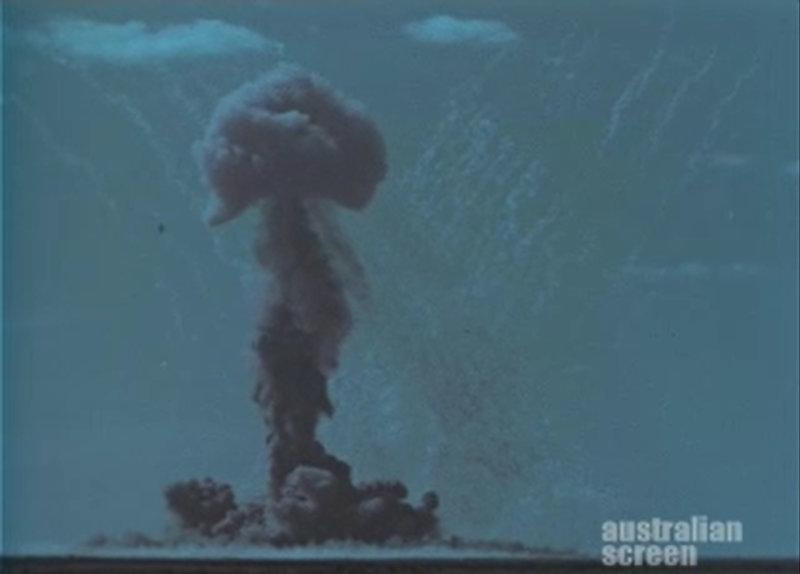Former human rights lawyer, now UK Prime Minister, Keir Starmer, gave explicit support to British nuclear test veterans to get compensation. One of his first acts as PM was to axe the post of Veterans Affairs Minister. Sue Rabbitt Roff reports from London.
In opposition, the Labour Party and Keir Starmer supported the claims of nuclear test victims for the poor health and early deaths many of them have suffered in the past seventy years. Many of these claims go all the way back to nuclear testing in Australia in the fifties, details of which British and Australian governments have spent decades suppressing.
A spokesman for the Help for Heroes charity, expressed disappointment at the decision, and that the [compensation] processes “are not fair or working properly, and many would be shocked by the way in which our service people and their families are treated.”
On the same day as the Veteran’s Ministry was demoted (it is now part of Defence Secretary John Healey’s portfolio), the Defence Department agreed to compensate thousands of veterans for hearing loss suffered during training or combat – a case that started in 2012.
Meanwhile, there has been no substantive response to the legal challenge raised by the well-regarded London human rights lawyers McCue Jury & Partners requiring the Ministry of Defence to give access to missing medical records and compensation for failures of duty of care to the 22,000 British and 16,000 Australian and New Zealand men who were required to be present at the atomic and nuclear tests.
Best we Forget – Australia’s 70 year old nuclear contamination secrets about to be exposed
A recently discovered archival document lists more than three hundred RAAF personnel who participated in the tests, including “a fully trained Canberra crew, five operational officers, Air Traffic Control, and 55 ground personnel at Maralinga” at the Buffalo tests. These were conducted in the weeks before the 1956 Olympic Games opened downwind in Melbourne and included what was claimed as Britain’s first ‘airburst’ detonation.
One of these was the ‘Kite test’, which we now know was not a (much ‘safer’) airburst test but a ground burst test, causing much more harm than those responsible would admit. Cover-ups are still being carried out.
The kite that dropped to the ground
Britain detonated 6 hybrid fission-fusion bombs in preparation for the detonation of the British thermonuclear H bomb off Christmas Island in 1957 or 1958.
The fifth test was ‘Kite’, detonated at Maralinga on October 11, 1956 – 6 weeks before the opening of the Olympic Games on November 22. For nearly 70 years, it has been officially described as an ‘airburst’ rather than a ground burst – despite the official photographic evidence that has been available online for at least 20 years.
The Atomic Weapons Tests Safety Committee published a report in 1958 stating that “one [weapon] was dropped from a Valiant bomber and fused to fire above the surface of the earth.” Over the page, it said that “On 11 October 1956, Round 3, also a device of low yield, was dropped from an aircraft and detonated above the surface of the desert.”
However, the film footage available online shows that, in fact,
Kite detonated on the surface and the fireball clearly behaved as a ground burst.
The British official historian of British atomic and nuclear testing in Australia, Lorna Arnold, wrote in 1987 of how the British Chiefs of Staff were talking of trials in 1955 or, as actually happened, in the Australian Spring of 1956. “They want [sic] an airburst to prove the ‘Blue Danube’ (MK1 bomb); the centre section had been exploded at Totem, and deliveries to the RAF had already begun, but an operational test was obviously desirable as soon as possible if only to give at least one aircrew the experience of dropping it.”

The explosion of Kite, one of the four nuclear fission bombs tested at Maralinga between September and October 1956. (aso.gov.au)
In 1990 the military historian Humphrey Wynn told a seminar on ‘The Origins and Development of the British Strategic Nuclear Deterrent Forces 1945-1960’ in the Royal Air Force Historical Society that “the first production bombs with this [atomic] warhead – Blue Danube – were delivered to RAF Wittering in 1953 . . . The eventual climax of the development effort – the bomb and the V bomber – occurred on 11 October 1956, when, in the Operation Buffalo trials at Maralinga, South Australia,
a live Blue Danube was successfully dropped from a Valiant of No 49 Squadron.
In 1981, Physicist Joseph Rotblat explained the difference between airburst and ground-level testing in a publication for the Stockholm International Peace Research Institute:
“For explosions above ground, the altitude of the burst and size of the fire-ball have an important bearing on the magnitude of the early fall-out. If the fire-ball touches the ground, the soil and other materials are vaporized and taken up with the fire-ball. The strong after-winds cause huge quantities of dirt and debris to be sucked up. They mix with the radioactive fragments of the bomb and form particles of various sizes which move upwards as well as spreading out. Later, they begin to fall to the ground under the force of gravity at rates and distances depending on the size of the particles and the velocity of the wind. This deposition of radioactivity constitutes the early, or local, fall-out. On the other hand, if the bomb is exploded at such a height that the fire-ball never touches the ground there is much less or even no local fall-out (but there will be global, or delayed, fall-out).”
Loving the bomb
According to Lorna Arnold, the Scientific Director of the tests, William Penney, stated that the “RAF did a lovely job. Brilliant flash and fireball. Some trees set on fire and many scorched. Terrific dust cloud and stem. Impressive scar on desert, surface torn and rocks scattered in central area. Atmosphere very dry and stable with inversion at 14000 ft where cloud stopped as predicted. Blast and heat indicate 3 to 4 kilotons.”
The 1985 Royal Commission on British Nuclear Tests in Australia still stated that “the explosion went as planned and it was a true airburst, i.e. the fireball did not reach the ground. The top of the cloud reached 15,000 feet.”
In total, 140 kilotons of nuclear weapons containing both fission and increasingly fusion/thermonuclear/H bomb components were detonated at the Monte Bellos and Maralinga in the six months before the opening of the 1956 Olympic Games downwind in Melbourne.
To quote Dr. Strangelove in Stanley Kubrick’s film of the same name, explaining what would happen after the bomb was dropped: “I would not rule out the chance to preserve a nucleus of human specimens. It would be quite easy…heh, heh…at the bottom of ah…some of our deeper mine shafts. Radioactivity would never penetrate a mine some thousands of feet deep, and in a matter of weeks, sufficient improvements in dwelling space could easily be provided.”
Sue Rabbitt Roff studied and taught at Melbourne and Monash Universities. Her recent writings on cultural aspects of settler colonial Australia have been published in Meanjin, Overland, the Conversation, the Independent and on Pearls & Irritations. She is currently writing a revisionist history of British atomic tests and nuclear trials in Australia.

